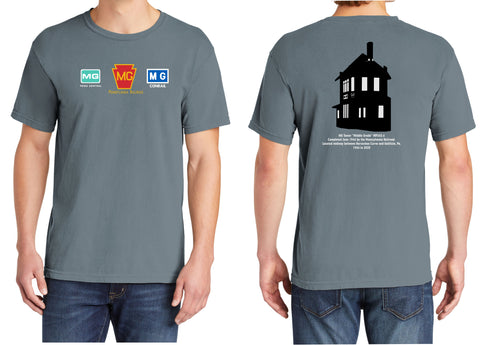
Erie Lackawanna Railway Co. Hoodie
Erie Lackawanna Railway Co. Hoodie
- Printed on Front
- 70/30 Blend
- Hood Color - EL Grey
The Interstate Commerce Commission approved the merger on September 13, 1960, and on October 17 the Erie Railroad and Delaware, Lackawanna and Western Railroad merged to form the Erie-Lackawanna Railroad.
Trains at the Erie Lackawanna rail yard in Waldwick on April 25, 1970
The EL struggled for most of the 16 years it existed. The two railroads that created it were steadily losing passengers, freight traffic and money; and were heavily burdened by years of accumulated debt and extensive, money-losing commuter operations. These two historic lines, the Erie and the DL&W, started to consolidate facilities on the Hudson River waterfront and across southern New York State in 1956, four years before formal corporate merger. The Lackawanna route was severely affected by the decline of anthracite and cement traffic from Pennsylvania by the 1940s. The Erie was burdened by the continuing loss of high-tariff fruit and vegetable traffic from the western states into the New York City region as highways improved in the 1950s. Both lines were also affected by the opening of the Saint Lawrence Seaway in 1959, which allowed ocean-going cargo ships to travel between European, African and South American ports and cities on the Great Lakes, such as Buffalo, Cleveland, Detroit, Duluth, Chicago, etc. The DL&W had previously carried much traffic to and from ocean ships, having its own port facilities at Hoboken Terminal on the Hudson River.
Erie Lackawanna MU cars at Gladstone, N.J. Station on April 25, 1970
The northeast's railroads, including the EL, were all beginning to decline because of over-regulation, subsidized highway and waterway competition, commuter operations, and market saturation (i.e., too many railroad lines competing for what market was remaining). The closure in the 1960s of old multi-story factories in the eastern cities, followed by the decline of the domestic automobile and steel industry in the 1970s, eroded much of the EL's traditional traffic base. Also, due to government regulation policy formulated in the late 19th century, the EL and other railroads could not immediately abandon long-distance passenger runs, despite the fact that competition from airlines, bus lines and the private automobile made them unprofitable.
However, the EL did post profits in the mid and late 1960s through heavy cost-cutting (reduction of parallel services), equipment modernization, suburban industrial development, increased piggy-back trailer traffic, and steady reduction of long-distance passenger train service, which ended on January 6, 1970. Also, additional rail traffic was temporarily diverted to the EL because of service problems on the troubled Penn Central lines, which the EL largely paralleled. The EL built a state of the art diesel engine repair facility in Marion, Ohio, and upgraded a large car repair shop in Meadville, Pennsylvania. As to its money-losing suburban passenger train services in the New York City metropolitan region, the EL had come to terms with the state of New Jersey during the late 1960s for adequate subsidy and for the purchase of new engines and coaches. The EL also gained a lucrative contract with United Parcel Service in 1970, which led to the operation of five dedicated intermodal trains daily between New Jersey and Chicago.




